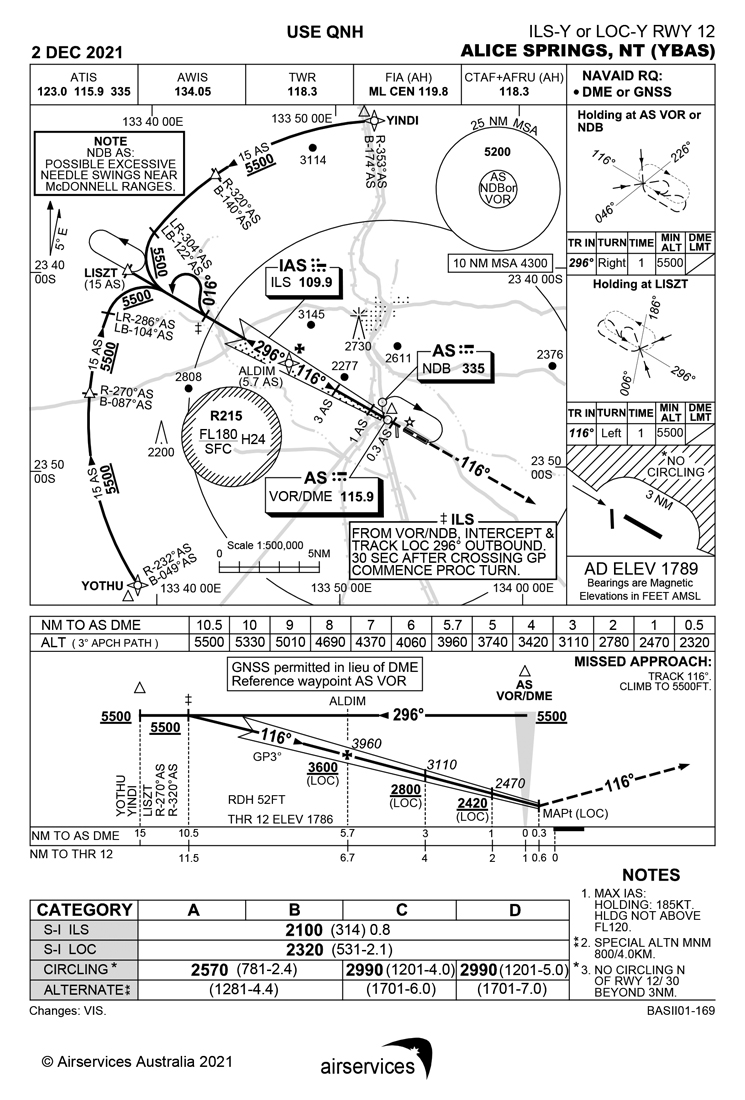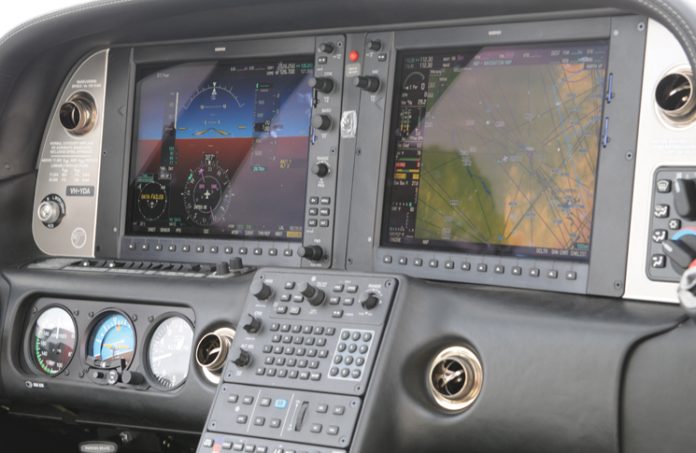
1. You are approaching YBAS and plan to conduct the ILS approach for runway 12. For some reason you are unable to acquire the ATIS QNH and instead use the TAF’s QNH. Assuming the aircraft has no PEC, what is the DA should you use?
- 2100 ft
- 2150 ft
- 2050 ft
- 2000 ft
2. You are established on the arc and overhead the waypoint YOTHU crossing the 232 radial as you’ll be positioning onto the ILS for the 296 radial. How many miles on the arc will you have travelled over the course during the procedure?
- 20 miles
- 18 miles
- 16 miles
- 14 miles
3. You’re currently established on the ILS approach and notice a discrepancy with the glideslope at the FAP. What should the pilot do under this circumstance and when is the latest time to initiate the missed approach procedure?
- continue with the ILS approach and conduct the missed approach by the DA
- immediately abandon the approach and conduct the missed approach procedure
- continue the approach on the localiser and conduct the missed approach at 0.6 AS DME
- continue the approach on the localiser and conduct the missed approach at 0.3 AS DME
4. You conduct the ILS approach for runway 12 as a CAT C aircraft. You are aware the wind is blowing 300° M/20 knots. You become visual by the circling MDA and consider conducting a circling approach to the northern side of the centreline. What should you do?
- The pilot in command is unable to conduct a circling approach to the north; however, they can manoeuvre to the south for runway 12.
- The pilot in command is not able to conduct a circling approach to the north as it exceeds the aircraft’s circling radius limit.
- The pilot in command can conduct the circling approach as long as they can conduct the approach safely.
- The pilot in command should immediately carry out the missed approach procedure and consider using another instrument approach for runway 30.
5. You are planning a flight into YBAS and intending to conduct the ILS-Y 12 approach as a CAT B aircraft.
TAF YBAS 201530Z 2018/2118
11030KT 9000 – DZ BKN035 SCT 020
BECMG 210500 12010KT 5000 +DZ BKN020
TEMPO 2106/2110 4500 +RA TS BKN015
T 25 23 16 16 Q 1015 1013 1005 1003
For a planned ETA of 0830Z at YBAS, are you required to plan an alternate?
- There is no operational requirement to plan for an alternate as the conditions are above the alternate minima.
- An alternate aerodrome needs to be planned as the cloud and visibility are less than the alternate minima.
- An alternate needs to be planned or 60 minutes of holding fuel must be carried due to the deteriorating weather conditions.
- An alternate needs to be planned or 60 minutes of holding fuel must be carried due to thunderstorms forecast for that period.
6. You are planning an IFR charter flight into Nyngan YNYN. Your aircraft is equipped with 2 GNSS TSO C129s along with an ADF and VOR. Based on navaid requirements, are you legally required to plan for an alternate for Nyngan?
- An alternate is not required as the aircraft has the required navaid equipment to conduct an instrument approach.
- An alternate is required as the aerodrome requires a ground-based navaid for planning purposes.
- An alternate is required as the aircraft’s GNSS equipment is not to the required TSO standards.
- An alternate is not required as Nyngan has a dedicated ground-based navaid.
7. You are endorsed on all instrument approaches. In the last 3 months, you have conducted 3 instrument approaches, which consisted of one ILS and 2 VOR approaches with RMI guidance. Have you met the required recency requirements as the holder of a command instrument rating?
- The pilot in command must also carry out an NDB approach within the last 3 months to maintain recency.
- No further approaches required as they satisfy recency within the 3 months.
- The pilot in command must also carry out RNAV and NDB approaches within the last 3 months to maintain recency.
- The pilot in command must carry out a VOR approach with CDI guidance within the last 3 months.
8. You are conducting an instrument approach with the intention of executing a missed approach procedure. Assuming you are not limited by high terrain, what guaranteed climb gradient for a missed approach must you achieve and from where along the approach path is the based from?
- 3.3% climb gradient based from the operating minima for the aircraft category
- 2.8% climb gradient based from the missed approach point
- 2.5% climb gradient based from the operating minima for the aircraft category
- 2.5% climb gradient based from the missed approach point.
Answers:
- (b) Refer AIP ENR 1.5 Para 1.19.3; ENR 1.5 Para 5.3.2
- (c) Solution the angular difference between the radials to cross through 296°R to 232°R = 64°R Rule: On a 15‑mile arc, for every 4 degrees of radials crossed, you have travelled one mile. Therefore, you would have travelled 16 nm after 64° radials.
- (d) Refer AIP ENR 1.5 Para 7.2 b; ENR 1.5 Para 7.3.1
- (a) Refer AIP ENR 1.5 Para 1.7.2; ENR 1.5 Para 1.7.6 Note 3.
- (d) Reference AIP ENR 1.1 Para 10.7.2.5
- (c) Reference AIP GEN 1.5 Para 2.1
- (b) Reference CASR 61.870
- (d) Reference AIP ENR 1.5 Para 1.10.1 Note 2



Question 1. Firstly, PEC is no longer. It went out with the changes on 2 December 21.
Secondly, although the PIC can’t get an accurate QNH which would be required to reduce the DA by 100 ft, he has used the TAF QNH. He will have to use the published DA of 2100 ft. The only time 50 ft is added to minima is when Area QNH is used. ENR 1.5 para 5.3.4.
Mr Walsh is correct. The question was prepared in August 2021 and reviewed by CASA and Flight Safety Australia’s quality assurance process. The answer was correct at the time but did not account for the 2 December 2021 changes. Call it human error.